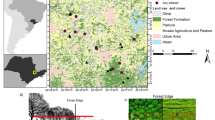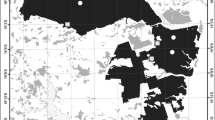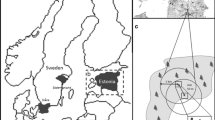Abstract
Context
Understanding the variability of vegetation distribution and its determinants is a central issue for addressing the effects of edges on ecological processes. Recent studies have revealed inconsistencies in the patterns of responses to edge effects that raise important questions about their determinants. We investigated the edge effect response patterns by adapting a recently proposed continuous approach to the case of small forest fragments in southwestern France.
Methods
We surveyed forest understory vegetation (composition, species richness, and percent cover) and abiotic variables (soil temperature, moisture, pH, and canopy openness) along 28 transects across hard forest edges. We tested five statistical models to describe the response pattern of each variable (1) over all transects and (2) per transect. We then compared the response patterns as a function of the attributes of the edge (orientation, topography, and adjacent land cover) and forest patch size.
Results
Over all transects, a general decreasing trend was observed for all variables as the distance from the edge increased. In the individual transects, we evidenced a large variability in the response patterns that was not related to edge attributes or to patch size.
Conclusion
It is difficult to assess the depth of edge influence in highly fragmented forests and to identify the determinants of edge effects. We recommend that care should be taken with studies using pool of transects, and that further studies should be carried out including situations with neutral patterns, in order to gain a broader understanding of edge effects on vegetation.

Similar content being viewed by others

References
Alignier A, Deconchat M (2011) Variability of edge effect on vegetation implies reconsideration of its assumed hypothetical pattern. Appl Veg Sci 14:67–74
Andrieu E, Ladet S, Heintz W, Deconchat M (2011) History and spatial complexity of deforestation and logging in small private forests. Landsc Urban Plan 103:109–117
Brosofske KD, Chen J, Crow TR (2001) Understory vegetation and site factors: implications for a managed Wisconsin landscape. For Ecol Manage 146:75–87
Brothers TS, Spingarn A (1992) Forest fragmentation and alien plant invasion of Central Indiana old-growth forests. Conserv Biol 6:91–100
Campbell SP, Witham JW, Hunter ML Jr (2010) Stochasticity as an alternative to deterministic explanations for patterns of habitat use by birds. Ecol Monog 80:287–302
Chabrerie O, Jamoneau A, Gallet-Moron E, Decocq G (2013) Maturation of forest edges is constrained by neighboring agricultural land management. J Veg Sci 24:58–69
Chen JQ, Franklin JF, Spies TA (1992) Vegetation responses to edge environments in old-growth Douglas-fir forests. Ecol Appl 2:387–396
Ewers RM, Didham RK (2006a) Confounding factors in the detection of species responses to habitat fragmentation. Biol Rev 81:117–142
Ewers RM, Didham RK (2006b) Continuous response functions for quantifying the strength of edge effects. J Appl Ecol 43:527–536
Ewers RM, Didham RK (2008) Pervasive impact of large-scale edge effects on a beetle community. Proc Natl Acad Sci 105:5426–5429
Fletcher RJ (2005) Multiple edge effects and their implications in fragmented landscapes. J Anim Ecol 74:342–352
Fonseca CR, Joner F (2007) Two-sided edge effect studies and the restoration of endangered ecosystems. Restor Ecol 15:613–619
Gehlhausen SM, Schwartz MW, Augspurger CK (2000) Vegetation and microclimatic edge effects in two mixed-mesophytic forest fragments. Plant Ecol 147:21–35
Gonzalez M, Ladet S, Deconchat M, Cabanettes A, Alard D, Balent G (2010) Relative contribution of edge and interior zones to patch size effect on species richness: an example for woody plants. For Ecol Manage 259:266–274
Harper KA, Macdonald SE, Burton PJ, Chen JQ, Brosofske KD, Saunders SC, Euskirchen ES, Roberts D, Jaiteh MS, Esseen PA (2005) Edge influence on forest structure and composition in fragmented landscapes. Conserv Biol 19:768–782
Honnay O, Verheyen K, Hermy H (2002) Permeability of ancient forest edges for weedy plant species invasion. For Ecol Manage 161:109–122
Johnson JB, Omland KS (2004) Model selection in ecology and evolution. Trends Ecol Evol 19:101–108
Jose S, Gillespie AR, George SJ, Kumar BM (1996) Vegetation responses along edge-to-interior gradients in a high altitude tropical forest in peninsular India. For Ecol Manage 87:51–62
Kapos V (1989) Effects of isolation on the water status of forest patches in the Brazilian Amazon. J Trop Ecol 5:173–185
Laurance WF, Yensen E (1991) Predicting the impacts of edge effects in fragmented habitats. Biol Conserv 55:77–92
McCollin D, Jackson JI, Bunce RGH, Barr CJ, Stuart R (2000) Hedgerows as habitat for woodland plants. J Environ Manage 60:77–90
Murcia C (1995) Edge effects in fragmented forests: implications for conservation. Trends Ecol Evol 10:58–62
Nakagawa S, Schielzth H (2013) A general and simple method for obtaining R2 from generalized linear mixed effects models. Methods Ecol Evol 4:133–142
Pellissier V, Bergès L, Nedeltcheva T, Schmitt M-C, Avon C, Cluzeau C, Dupouey J-L (2013) Understory plant species show long-range spatial patterns in forest patches according to distance-to-edge. J Veg Sci 24:9–24
Pinheiro J, Bates D, DebRoy S, Sarkar J and the R Development Core Team (2012) nlme: linear and nonlinear mixed effects models. R package version 3.1-104.
Prodon R, Lebreton J-D (1981) Breeding avifauna of a Mediterranean succession: The Holm oak and cork oak series in the eastern Pyrenees, 1. Analysis and modeling of the structure gradient. Oikos 37:21–38
R Development Core Team (2008) R: A language and environment for statistical computing. Vienna, Austria
Ranney JW, Bruner MC, Levenson JB (1981) The importance of edge in the structure and dynamics of forest islands. In: Burgess R.L. and Sharpe D.M. (Eds), Forest island dynamics in man-dominated landscapes, Springer Verlag, pp. 67–95.
Ries L, Fletcher Jr RJ, Battin J, Sisk TD (2004). Ecological responses to habitat edges: mechanisms, models, and variability explained. Ann Rev Ecol Evol Syst 35:491–522
Ries L, Sisk TD (2010) What is an edge species? The implication of edge sensitivity to habitat edges. Oikos 119:1636–1642
Tutin TG, Burges NA, Chater AO, Edmondson JR, Heywood VH, Moore DM, Valentine DH, Walters SM, Webb DA (1993) Flora europaea, Cambridge Univ. Press, 581 p
Vellend M, Verheyen K, Jacquemyn H, Kolb A, Van Calster H, Peterken G, Hermy M (2006) Extinction debt for forest plants persists for more than a century following habitat fragmentation. Ecology 87:542–548
Weathers KC, Cadenasso ML, Pickett STA (2001) Forest edges as nutrient and pollutant concentrators: potential synergisms between fragmentation, forest canopies, and the atmosphere. Conserv Biol 15:1506–1514
Williams-Linera G (1990) Vegetation structure and environmental conditions of forest edges in Panama. J Ecol 78:356–373
Acknowledgments
We thank Laurent Burnel, Jérôme Willm, and Marc Fakorellis for their assistance in the field. We are also grateful to Alain Cabanettes and Michel Goulard for providing comments on statistical analysis. We thank Huw ap Thomas (Axtrad) for thorough editorial advice in English. We thank the three anonymous reviewers for their constructive comments. Funding for this study was provided by the French Ministry of Research and Education.
Author information
Authors and Affiliations
Corresponding author
Additional information
Handling Editor: Jean-Luc Dupouey
Contribution of the co-authors
AA and MD conceived and designed the experiments. AA performed the experiments and data analysis. AA and MD analyzed results. AA and MD wrote the manuscript.
Electronic supplementary material
Below is the link to the electronic supplementary material.
Online Resource 1
Summary of the best mixed effect models selected by AIC weights amongst the five statistical models tested (null, linear, exponential, logistic, and unimodal), for each variable (n = 7) over all transects (n = 28). F and p value (p) from ANOVA type III error tests are given. S south, N neutral, and M meadow. (DOCX 22 kb)
Online Resource 2
Summary of best models selected by AIC weights for each variable (n = 7) and each transect (n = 28). ∆ AIC between the best model and alternative statistical models were given. Can. Open canopy openness, Exp exponential, Uni unimodal, nc nonconvergence of models (DOCX 76 kb)
Rights and permissions
About this article
Cite this article
Alignier, A., Deconchat, M. Patterns of forest vegetation responses to edge effect as revealed by a continuous approach. Annals of Forest Science 70, 601–609 (2013). https://doi.org/10.1007/s13595-013-0301-0
Received:
Accepted:
Published:
Issue Date:
DOI: https://doi.org/10.1007/s13595-013-0301-0



